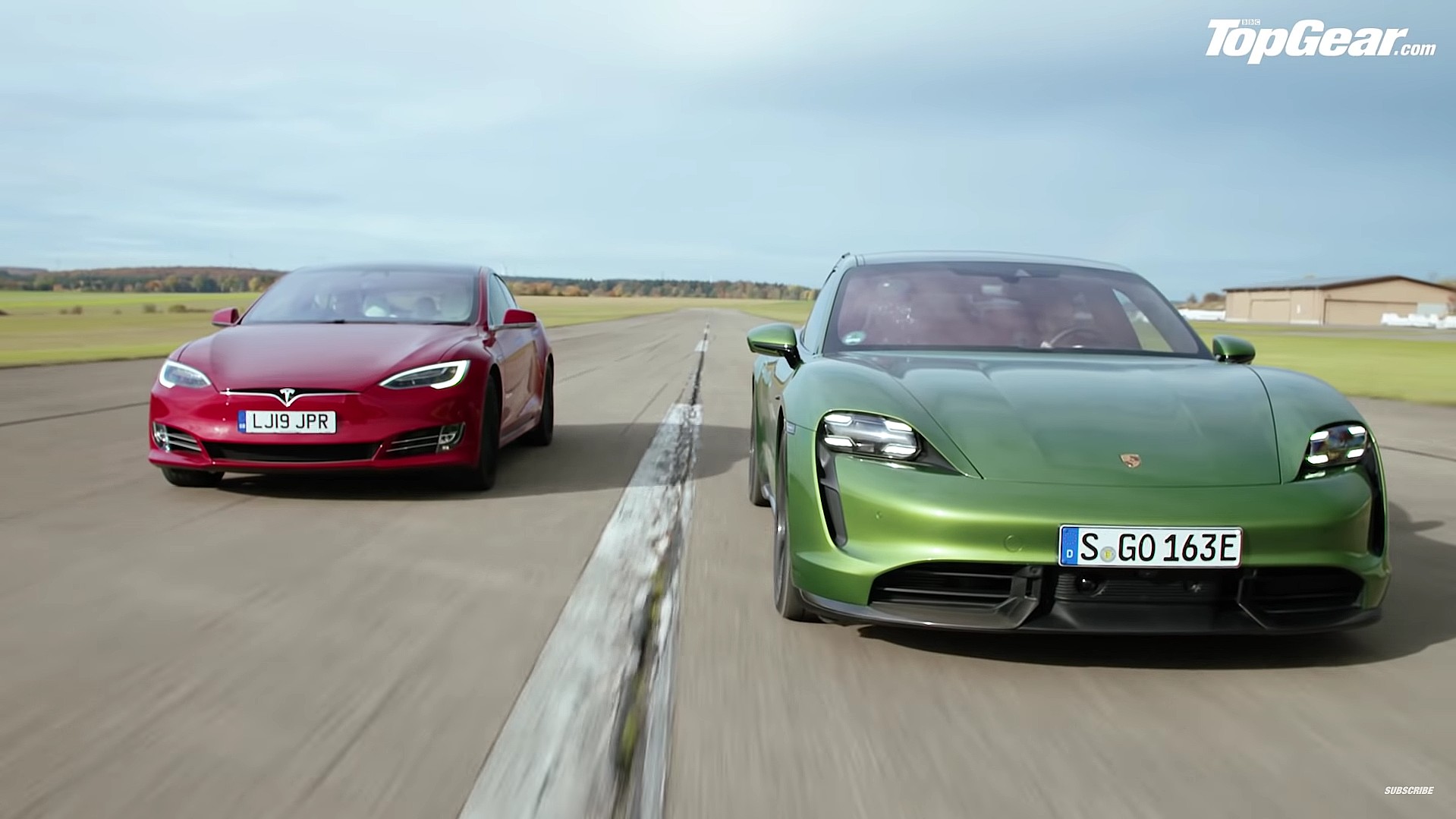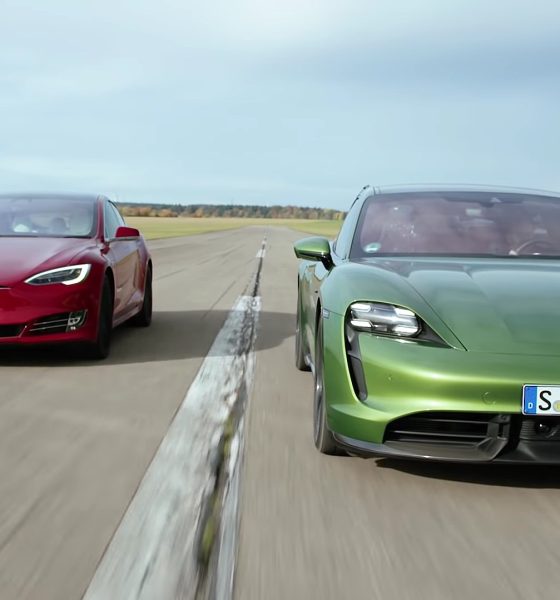

News
Top Gear doubles down on Tesla vs Porsche race, claims Model S’ actual results are worse
Top Gear‘s saga involving a drag race between the Tesla Model S Performance and the Porsche Taycan Turbo S continues to unravel, as CEO Elon Musk expressed his comments on Twitter and the motoring publication posted an update defending its results.
Following the release of a thorough analysis of the Model S vs Porsche Taycan drag race which suggested that Top Gear did not engage the Tesla’s Launch Mode and full Ludicrous Plus capabilities in the race, CEO Elon Musk took to Twitter to offer his take on the two vehicles’ bout. According to Musk, Top Gear did miss the Model S’ real performance figures, especially since the numbers published by the motoring publication were inconsistent with what regular Tesla owners have recorded on their vehicles.
Amidst criticism from the electric car community, Top Gear has issued a response explaining its Model S Performance vs Taycan Turbo S drag race results. Quite surprisingly, the motoring publication admitted that they did use Model S figures from a previous race in the Tesla vs Porsche drag battle. Even more surprisingly, Top Gear claimed that this was done in favor of the Tesla Model S Performance.
Explaining its results, Top Gear stated that the best figures recorded for the Tesla Model S Performance during its battle with the Taycan were a 0-60 mph time of 2.83 seconds, a 0-100 mph time of 6.64 seconds, and a quarter-mile time of 11.23 seconds at 123.2 mph. These figures were worse than the 0-60 mph time of 2.68 seconds, 0-100 mph time of 6.46 seconds, and quarter-mile time of 11.08 seconds at 124.0 mph listed by the publication in its comparative video.
“These were numbers we recorded in a Model S on a previous occasion. We ran them because these are the best figures we’ve achieved in a Model S to date so we know that’s what the car is capable of. And just to be clear, the Tesla was in Ludicrous+ mode, the battery was pre-conditioned and both cars had around 85 per cent charge before the first run,” Top Gear wrote.
Looking at Top Gear‘s statement and clarification, it appears that the motoring publication is suggesting that the Raven Model S Performance actually has worse capbilities than a vehicle that it used from back in 2017. This does not align with the experiences of Tesla owners at all, many of whom have reported that the Raven Model S Performance can actually outrun a Tesla Model S P100D in the quarter-mile.
Interestingly, Top Gear‘s clarification did not address the main concern expressed by the Tesla community about the Model S vs Taycan race — that the Tesla was not in Launch Mode during its drag battle with the German-made all-electric sports car. This, apart from the fact that a video of the Model S’ interior while it was racing with the Taycan showed that the vehicle’s Range Mode was activated, further clouds Top Gear‘s defense of its race.
Overall, it is quite disappointing to see Top Gear standing by its Tesla Model S Performance vs Porsche Taycan Turbo S drag race results. With the race practically debunked, it would not be in the Porsche Taycan’s best interests to run away with a win from the Model S at this point. The Taycan deserves a clean win, and it is something that it can actually achieve, considering its dual-speed gearbox. Simply put, it would be better for Top Gear at this point to race the two vehicles again, this time with both cars on Launch Control, and this time with an actual Raven Model S, to provide an accurate depiction of a drag race between these two excellent vehicles.

News
Tesla FSD fleet is nearing 7 billion total miles, including 2.5 billion city miles
As can be seen on Tesla’s official FSD webpage, vehicles equipped with the system have now navigated over 6.99 billion miles.

Tesla’s Full Self-Driving (Supervised) fleet is closing in on almost 7 billion total miles driven, as per data posted by the company on its official FSD webpage.
These figures hint at the massive scale of data fueling Tesla’s rapid FSD improvements, which have been quite notable as of late.
FSD mileage milestones
As can be seen on Tesla’s official FSD webpage, vehicles equipped with the system have now navigated over 6.99 billion miles. Tesla owner and avid FSD tester Whole Mars Catalog also shared a screenshot indicating that from the nearly 7 billion miles traveled by the FSD fleet, more than 2.5 billion miles were driven inside cities.
City miles are particularly valuable for complex urban scenarios like unprotected turns, pedestrian interactions, and traffic lights. This is also the difference-maker for FSD, as only complex solutions, such as Waymo’s self-driving taxis, operate similarly on inner-city streets. And even then, incidents such as the San Francisco blackouts have proven challenging for sensor-rich vehicles like Waymos.
Tesla’s data edge
Tesla has a number of advantages in the autonomous vehicle sector, one of which is the size of its fleet and the number of vehicles training FSD on real-world roads. Tesla’s nearly 7 billion FSD miles then allow the company to roll out updates that make its vehicles behave like they are being driven by experienced drivers, even if they are operating on their own.
So notable are Tesla’s improvements to FSD that NVIDIA Director of Robotics Jim Fan, after experiencing FSD v14, noted that the system is the first AI that passes what he described as a “Physical Turing Test.”
“Despite knowing exactly how robot learning works, I still find it magical watching the steering wheel turn by itself. First it feels surreal, next it becomes routine. Then, like the smartphone, taking it away actively hurts. This is how humanity gets rewired and glued to god-like technologies,” Fan wrote in a post on X.
News
Tesla starts showing how FSD will change lives in Europe
Local officials tested the system on narrow country roads and were impressed by FSD’s smooth, human-like driving, with some calling the service a game-changer for everyday life in areas that are far from urban centers.

Tesla has launched Europe’s first public shuttle service using Full Self-Driving (Supervised) in the rural Eifelkreis Bitburg-Prüm region of Germany, demonstrating how the technology can restore independence and mobility for people who struggle with limited transport options.
Local officials tested the system on narrow country roads and were impressed by FSD’s smooth, human-like driving, with some calling the service a game-changer for everyday life in areas that are far from urban centers.
Officials see real impact on rural residents
Arzfeld Mayor Johannes Kuhl and District Administrator Andreas Kruppert personally tested the Tesla shuttle service. This allowed them to see just how well FSD navigated winding lanes and rural roads confidently. Kruppert said, “Autonomous driving sounds like science fiction to many, but we simply see here that it works totally well in rural regions too.” Kuhl, for his part, also noted that FSD “feels like a very experienced driver.”
The pilot complements the area’s “Citizen Bus” program, which provides on-demand rides for elderly residents who can no longer drive themselves. Tesla Europe shared a video of a demonstration of the service, highlighting how FSD gives people their freedom back, even in places where public transport is not as prevalent.
What the Ministry for Economic Affairs and Transport says
Rhineland-Palatinate’s Minister Daniela Schmitt supported the project, praising the collaboration that made this “first of its kind in Europe” possible. As per the ministry, the rural rollout for the service shows FSD’s potential beyond major cities, and it delivers tangible benefits like grocery runs, doctor visits, and social connections for isolated residents.
“Reliable and flexible mobility is especially vital in rural areas. With the launch of a shuttle service using self-driving vehicles (FSD supervised) by Tesla in the Eifelkreis Bitburg-Prüm, an innovative pilot project is now getting underway that complements local community bus services. It is the first project of its kind in Europe.
“The result is a real gain for rural mobility: greater accessibility, more flexibility and tangible benefits for everyday life. A strong signal for innovation, cooperation and future-oriented mobility beyond urban centers,” the ministry wrote in a LinkedIn post.
News
Tesla China quietly posts Robotaxi-related job listing
Tesla China is currently seeking a Low Voltage Electrical Engineer to work on circuit board design for the company’s autonomous vehicles.

Tesla has posted a new job listing in Shanghai explicitly tied to its Robotaxi program, fueling speculation that the company is preparing to launch its dedicated autonomous ride-hailing service in China.
As noted in the listing, Tesla China is currently seeking a Low Voltage Electrical Engineer to work on circuit board design for the company’s autonomous vehicles.
Robotaxi-specific role
The listing, which was shared on social media platform X by industry watcher @tslaming, suggested that Tesla China is looking to fill the role urgently. The job listing itself specifically mentions that the person hired for the role will be working on the Low Voltage Hardware team, which would design the circuit boards that would serve as the nervous system of the Robotaxi.
Key tasks for the role, as indicated in the job listing, include collaboration with PCB layout, firmware, mechanical, program management, and validation teams, among other responsibilities. The role is based in Shanghai.
China Robotaxi launch
China represents a massive potential market for robotaxis, with its dense urban centers and supportive policies in select cities. Tesla has limited permission to roll out FSD in the country, though despite this, its vehicles have been hailed as among the best in the market when it comes to autonomous features. So far, at least, it appears that China supports Tesla’s FSD and Robotaxi rollout.
This was hinted at in November, when Tesla brought the Cybercab to the 8th China International Import Expo (CIIE) in Shanghai, marking the first time that the autonomous two-seater was brought to the Asia-Pacific region. The vehicle, despite not having a release date in China, received a significant amount of interest among the event’s attendees.








